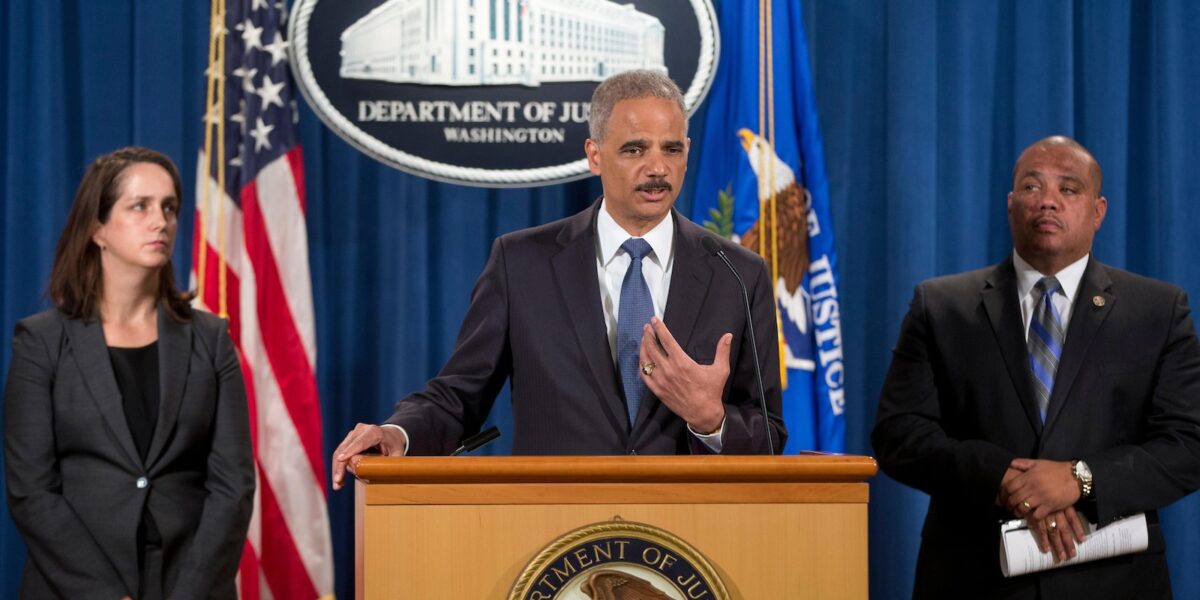WASHINGTON — As the first images out of Ferguson, Missouri surfaced 10 years ago — the bloodied body of a man left for hours in the street beneath white sheets, protesters smashing car windows and looting stores — it didn’t take long for the federal government to see a role for itself.
Acting with notable haste, the FBI within two days opened a criminal investigation into the killing of Michael Brown at the hands of a police officer, while the Justice Department less than a month later launched a civil rights inquiry culminating in a devastating report that identified abuses by the city’s overwhelmingly white police force and court system.
The investigations catapulted the department’s Civil Rights Division into the spotlight, bringing heightened publicity to a unit whose work since its 1957 creation included fighting for voting rights and prosecuting Los Angeles police officers in the beating of Rodney King. The Ferguson probes became part of a cluster of high-profile investigations into police departments, work that fed a national dialogue on race and law enforcement and formed a legacy item of the Obama administration Justice Department before being largely abandoned under President Donald Trump. Inquiries into big-city police forces returned under President Joe Biden.
“I can’t tell you the number of chiefs I’ve talked to who told me that they had their officers read the Ferguson report, that they did trainings around it,” said Vanita Gupta, who took over the Civil Rights Division two months after Brown’s death and held the position for the remainder of the Obama administration. “It became a document that had a life far beyond Ferguson and really triggered conversations nationwide around justice and policing.”
___
This story is part of an ongoing series by The Associated Press exploring the impact, legacy and ripple effects of what is widely called the Ferguson uprising, sparked a decade ago by the fatal shooting of Brown.
___
The public outcry in Ferguson didn’t occur in a vacuum, coming two years after the killing of Black teenager Trayvon Martin by a neighborhood watch volunteer in Florida and on the heels of a spate of federal investigations that exposed pervasive problems in police departments in Seattle, Albuquerque and Newark, New Jersey. In Ferguson itself, residents protested not only Brown’s death but also years if not decades of mistreatment by police and city officials.
“It was this constant, daily experience of hostile engagement with law enforcement. People were afraid to go out of their homes. They were afraid to drive because they didn’t want to get stopped. They knew that each one of those encounters would be a negative encounter,” said Jonathan Smith, who headed the Civil Rights Division section that investigated Ferguson and other troubled police forces.
Brown was killed Aug. 9, 2014 in a violent altercation with officer Darren Wilson that began when Wilson ordered the 18-year-old, who was walking with a friend down the middle of a street, onto the sidewalk. The following day, after a candlelight vigil, protesters smashed car windows and carried away stolen items from stores. The night after that, police fired tear gas and rubber bullets into a crowd to try to disperse protesters.
As community unrest grew, with protesters clashing with officers in armored vehicles and military-style equipment, President Barack Obama dispatched Attorney General Eric Holder to Ferguson, where he met with law enforcement and community leaders. In a trip that underscored the administration’s determination to quell the turbulence, Holder appealed for calm in the community and met Brown’s parents, saying later that he had greeted them not only as attorney general but as the father of a teenage son.
Besides the investigation into Brown’s death, the Justice Department separately opened a civil inquiry into the entire police department.
Officials scoured more than 35,000 pages of police records and found city emails containing racist language. They analyzed data on stops, searches, citations, arrests and use-of-force. The team — which included attorneys, an investigator and community engagement specialists — participated in police ride-alongs, attended court proceedings and spent hours in coffeeshops talking to residents.
The result was a scathing March 2015 report documenting eye-popping police abuses. Even though the department didn’t find sufficient evidence for criminal charges in Brown’s death, a decision that disappointed protesters seeking justice, the broader report into the police department resonated across the nation, as many people outside Ferguson recognized similar abuses by their law enforcement.
“There are Fergusons all around the country where attention is needed to rebuild community trust — which, of course, is ultimately key to public safety,” said Chiraag Bains, a former senior counselor in the Civil Rights Division who helped lead the Ferguson investigations.
The report showed how Black residents were disproportionately subjected to excessive force and baseless searches-and-seizures, practices the Justice Department said reflected racial bias within the city. It accused the city of using law enforcement operations to generate revenue rather than for legitimate public safety purposes. Among the examples of abuse it cited: one man was charged with violating the city’s municipal code for purported infractions like not wearing a seatbelt despite sitting in a parked car and for giving the shortened form of his name — “Mike” instead of “Michael.”
The Justice Department and Ferguson in 2016 entered into a consent decree requiring the police department to make significant reforms.
Such agreements aren’t the “the end all, be all,” said Gupta, since they’re limited to resolving policing problems but don’t necessarily address longstanding race-based disparities. That can be be frustrating, she said, because police-community breakdowns can often be the “tip of the spear to more entrenched societal inequities.”
Even so, she said, one consequence of the department’s policing work in Ferguson was that community leaders and political figures began calling for federal intervention after similar deaths. That’s what happened in Baltimore, for instance, where the Justice Department launched a sweeping investigation into the city police department after Freddie Gray’s death, and in Chicago, where a federal inquiry into the Chicago force was opened after Laquan McDonald was fatally shot by a police officer.
The focus of the Civil Rights Division changed dramatically in the Trump administration. Trump’s first attorney general, Jeff Sessions, announced weeks after taking office a review of pattern-or-practice investigations that all but nullified a process he said unduly smeared entire police forces.
But the investigations picked up again early in the Biden administration, with a new Justice Department leadership entering their positions in the aftermath of George Floyd’s killing in Minneapolis. Since April 2021, the Civil Rights Division says it’s launched 11 pattern-or-practice investigations into law enforcement agencies, including police departments in Minneapolis, Louisville and Phoenix. It’s currently enforcing consent decrees with 12 law enforcement agencies, including Ferguson police.
Christy Lopez, a former Justice Department official who led the team that investigated Ferguson, said that while she was not satisfied with the pace of work, there’s no question “we are in a better place than we were 10 years ago in terms of how we think about and how we are actually working to change policing.”
But much work remains, Lopez said.
“Not only do we still have a long way to go, but it’s not at all clear that we will continue moving forward,” she said. “And it’s very clear that people’s lives are being lost and lives are being destroyed because of our inability to actually be sensible about things, to not politicize everything.”


